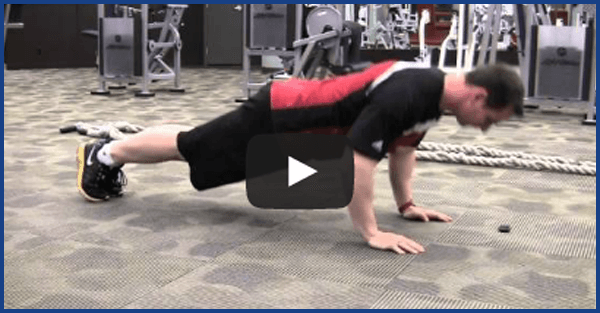One exercise that tends to get butchered more than any other is the pushup. Due, in large part, to its' relative ease to perform, lack of specific impact, and overall impact on the body, the pushup is a popular exercise choice.
I'd estimate that one person in 25 can actually do a pushup properly. To perform it properly it takes a lot of strength from the scapular stabilizers, specifically from muscles like the lower trapezius, serratus anterior, and latissimus dorsi.
For all the anatomy buffs out there pushing their glasses back up on their noses and waving a proud finger in the air to proclaim "Those are all back muscles and antagonists to the pushup!!"
Yes, you're right, they are. And if you're interested in fixing bad pushups, they need to be strong and stable.
But much as the hamstrings are the antagonists to the quadriceps at the knee and are arguably more important from a stability perspective in the function of the knee, the muscles of the back are more important for scapular stability than the muscles on the front.
Charlie Weingroff illustrates this point beautifully with the slingshot analogy.
The handle for the slingshot is the stable base, while the elastic of the sling is the mobile section producing movement. The base has to be stable enough to allow the elastic to generate tension and force through a big range of motion. By building a strong structure to hang a mobile segment off of, you can essentially get that mobile section to increase its' force production dramatically without altering its' strength.
As a bit of an experiment, I took a couple of clients through a small experiment last year. I measured their bench press, then took them through 4 weeks of no upper body pushing exercises, only pulling and stabilizing exercises, then re-tested their bench press. The average increase was about 25 pounds, give or take, with one accountant increasing his by 45 pounds (this is a dude closing in on 60, by the way). These weren't your typical athletes looking for a signing bonus, but rather desk jockeys looking to not wind up hating life by the end of the day.
While not a significant study, it showed that, by working on building a strong foundation, we could increase the mobility section in the shoulder and its' ability to produce force without working that area directly.
This is where pushups come in. Most people have terrible stability. As a result, they wind up hanging with their shoulders about 5 inches from their rib cage, a condition commonly known as winging.
If the spine is defined by the ability of the core to maintain position as being stable, this is the equivalent of a spine following a disc injury. It's hanging by passive restraints, and will eventually fail, leading to rotator cuff irritation and some dumbass trainer or therapist prescribing 50 sets of banded external rotation to fix the rotator cuff problem.
If the person has no stability in their shoulders, they will inevitably hang in a near winged position, which puts more pressure on other stabilizing structures like the neck, rotator cuff, and biceps tendon.
4 Types of Pushups That Desperately Need Fixing
#1: The Neckless
These pushers are notable for their complete lack of neck. For some reason, their shoulders have conjoined with their ears, making them press their head forward and towards the mat in a vain attempt to hit the floor sooner, thus reducing the need to actually bend the elbows.
The shoulders going into the neck is one of the main indicators of a lack of scapular stability, which means all the muscles connecting to the scapula aren't able to hold the shoulder blade in the right position against the force of gravity, and the muscles wind up just hanging the shoulder blade off fascial tension instead of providing co-contraction forces to increase the reaction in the pecs and deltoids.
One way to correct this would be to elevate the surface so the amount of force being applied to the upper body is reduced, and then work on getting a lot of horizontal and vertical pulling movements in to increase the stability of the scapula to provide a good foundation for the arm to push off of.
To fix the Neckless - Have your client perform the movement with his or her hands on an elevated surface, like a box. In addition, increase the amount of horizontal and pulling movements to strengthen the stability of the scapula.
#2: Spinal Hinge
The people look like they're rocking their own version of the worm from the 80"²s. They're also conspicuous from their constant complaints of why their backs are so sore from almost everything they do. Gee, I wonder why??
These guys not only have minimal scapular stability, they lack any ability to keep their core tense to generate a push from their upper body into their lower body efficiently.
These are also the folks who round like crazy on their deadlifts and squats and chalk it up to their tight hamstrings. Wanna know why your hamstrings are tight, chief? It's because they're all that's keeping your spine from going all Sub-Zero from Mortal Kombat and exploding out of your back entirely in an epic finisher.
The first way to fix this is probably the same way you would teach a puppy not to poop in the hallway. Although rubbing their nose in it wouldn't be all that ideal, video taping the movement and showing them how much of an ass-clown they look like and then saying "NO!! BAD BOY!! STOP DOING THAT!!" may be more effective.
Another approach would be to work on core stability exercises that would resist the body moving through flexion and extension directions, so called "anti" movements.
To fix the Spinal Hinge - Work on core stability, in particular anti-rotation movements. The half-kneeling Pallof Press is a good option.
#3: The Venus Fly Trap
This one is most notable by the shoulder blades desire to clamp shut together during the eccentric movement. This has resulted in more disappearances of sports bra straps than socks lost in the dryer.
Forward the video to 1:28 to see the the Venus Fly Trap:
This isn't as severe as the neckless one, but it's still a scapular stability issue. This could be best trained by making the person really focus on making sure they hold their scapula stiff and solid against the ribs instead of letting them flail around all over the place. It would also help to not have the hands so wide, elbows flared, or letting the individual sink into their neck when they get tired.
To fix the Venus Fly Trap - Have your client set up with his or her hands closer together in addition to constant cueing to keep the scapula stuff.
#4 : The Sexy Beast
This guy is thinking about a different exercise, but he's still giving it all he's got, which isn't much, but at least he's giving it.
This shows a complete avoidance of using the upper body and essentially invokes some sort of reproductive act best saved for behind closed doors.
To fix the Sexy Beast - Seeing as this person isn't doing a pushup in the first place, it's probably best to simply re-teach the exercise from the start. That, and avoid any inadvertent baby-making that might happen if you get in the way.
What a Pushup Should Look Like
Now an ideal pushup should have two segments moving: glenohumeral joint (aka shoulder to the non-Poindexters out there), and elbows. Everything else is just pivoting on the toes and making a stiff, straight and strong lever from the shoulders to the toes.
The best way to achieve this is to simply flex everything and not allow any movement from anywhere other than through the shoulders. That means glutes, abs, lats, rhomboids, neck flexors, hair follicles, eyelids, and anything else you could throw into the pot for a tasty tasty stew of McHappiness.
At the end of the day, the pushup should be working the pecs, anterior deltoids and triceps.
If you feel something else other than these muscles burning at the end of a set, chances are you're probably doing something wrong and need to change it up before I start face-palming your attempts to look cool in front of the figure competitor chicks by rocking out some no-neck pushups.










